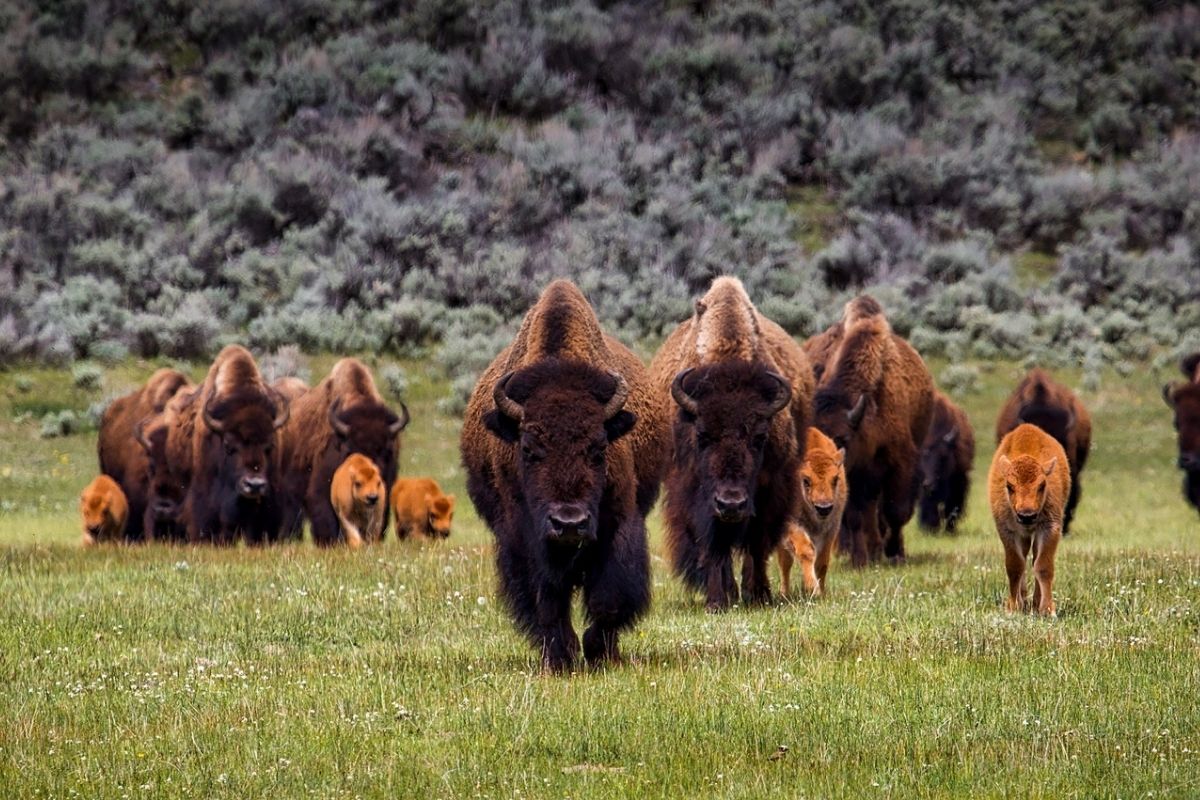By Nicole Rivard
The American bison, sometimes called the American buffalo, an animal once hunted to the brink of extinction in this country, became the U.S.’s first national mammal in 2016, putting it on a par with the bald eagle as a symbol of the nation.
However, while some have called the designation a milestone in the effort to prevent the bison from going extinct and to recognize the bison’s ecological, cultural and historical importance to our country, the truth is it doesn’t give them any protection at all.
For example, every winter state and federal agencies continue to shoot free-roaming bison in and around Yellowstone National Park in Wyoming as part of the Interagency Bison Management Plan—which began in 2000 under pressure from Montana’s Department of Livestock—under the guise of disease risk management.
And that’s just a bunch of bull.
The way our national mammal is treated is a national disgrace. These are the ancestors of the great herds that once roamed North America. There would be a groundswell of public backlash if state and federal agencies were shooting bald eagles out of the sky.
Every winter and spring, snow and ice cover the Yellowstone buffalo’s forage, so hunger pushes them to lower elevations across the park boundary in Montana and national forest land. When they cross these arbitrary lines, they enter a war zone with ranchers.
Nearly 3,500 bison have been slaughtered just in the last five years to cater to unfounded fears of transmission risk to local livestock operations of brucellosis, a non-native disease introduced to the region by livestock. However, a study by the National Academy of Sciences found that of all the instances of brucellosis transmission from wildlife to domestic cattle, not one single incident was attributable to bison.
Only about 5,400 Yellowstone bison exist today, and that number fluctuates. With each intensive management action a little more of the wildness that makes the herds so unique is eroded. One of the two Yellowstone herds—the Central Interior Herd—may already be too small to maintain its viability from a genetic standpoint.
That’s why since 2014 Friends of Animals, along with Buffalo Field Campaign and Western Watersheds Project, has been advocating to have the Yellowstone bison herds listed under the Endangered Species Act, arguing the two separate groups of bison in the park are genetically distinct from each other. We recently won our second lawsuit against the U.S. Fish and Wildlife Service because the agency violated the law when it dismissed scientific evidence that Yellowstone bison may warrant protection under the ESA, requiring the agency to take another look at the listing request.
FWS continues to ignore scientific evidence that the Central Interior Herd and Northern Herd are genetically distinct. The current Interagency plan treats bison as a single herd, failing to provide safeguards to maintain both herds as distinct units that need to be protected.
What’s at stake?
We have a lot to lose if the Yellowstone bison go extinct. They are the only genetically intact, truly wild plains bison—meaning they have no cattle genes and still behave like wild animals. The fact that the killing targets wild bison who still have a strong migrating instinct makes it even more barbaric.
The only other intact plains bison herd is in Utah’s Henry Mountains as it was founded with Yellowstone bison, according to Buffalo Field Campaign. Some of the bison herd managers in other locations such as National Bison Range and Wind Cave claim otherwise, but there have not been any published peer reviewed papers to support those claims.
Most of the bison that people see today live on ranches and are raised as livestock. Approximately 300,000 bison are commercially propagated on 4,000 farms and ranches in North America according to the latest data from the International Union for the Conservation of Nature’s Red List of Threatened Species Red List. These “domestic” buffalo carry cattle genes, due to efforts to make a heartier doomed cow that will become somebody’s hamburger. The result is a contamination of the wild bison bloodlines.
Compare those numbers with just 31,000 total bison in 68 conservation herds in North America. These include about 20,000 plains bison and 11,000 wood bison.
Our national mammal should be admired and respected and left alone to flourish in their own way. For one, bison have an astounding sense of community. When they travel through deep snow they often walk in single file, the lead bison taking on the exhausting work of breaking trail. When the lead bison gets tired, he or she will step aside to allow a new one to take the lead. When pursued by wolves, the stronger and larger bulls face outward around the rim facing the predators. Calves, weaker and older members of the herds will stay near the center of the circle, protected by the outward facing bulls.
Bison also know how to cherish wildness, something humans should emulate.
Darrell Geist, habitat coordinator for Buffalo Field Campaign, recently shared with me how one day on patrol he came upon a family of buffalo in a grass and sage meadow on Horse Butte peninsula, the Central herd’s calving grounds in Hebgen basin. It was a matriarch group consisting of great grandmothers, grandmothers, mothers, calves of the year, yearlings, some two-year-olds and a couple of bulls still too young to join the bachelor groups.
“I don’t remember who started it, but the buffalo got all excited, playing and frolicking, a wave of fun and joy rippling through the herd. It was electric,” Geist said. “One buffalo began jumping in the air, leaping and bounding on all fours. Red calves were darting through the herd, running around and chasing one another, getting the group to pile on to the fun. Buffalo playfully head butted one another, snorting and rubbing, side to side, head-to-head with the older females—no buffalo was left out. Calving time is a good time to see, from a respectful distance, buffalo enjoying being buffalo.”

